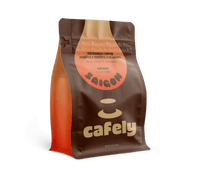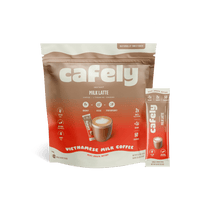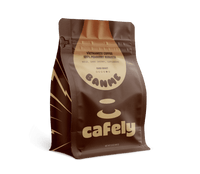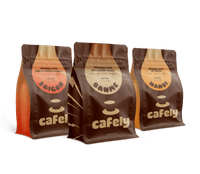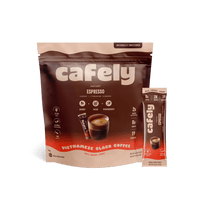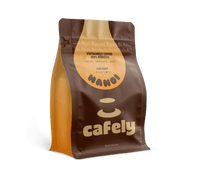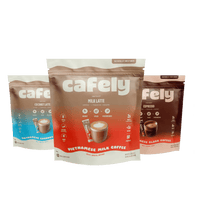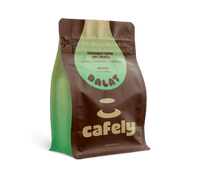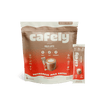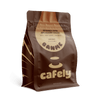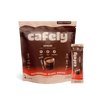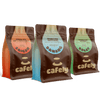Low-acid coffee can be divided into two categories.
It could just be a coffee with a low pH score or a coffee with less astringency of flavor.
We'll review some of the best low-acid coffees on the market before looking at the science behind your brew and whether it is a less acerbic option.
Before we get into the details, here's a list of the types of coffees that tend to have the lowest acidity overall:
- Vietnamese Coffee — Dark-roasted robusta with high 5-CQA; smooth, rich, low-acid.
- Dark Roasts — Low in low-pH acids; smoother, less acidic.
- Light Roasts — High in low-pH acids like 3-CQA; bright, citrusy, or fruity flavors.
- Robusta Beans — Naturally lower in low-pH acids; earthy and full-bodied.
- Brazilian Coffees — Grown at medium altitudes; nutty, chocolatey, and low in acidity.
- Low-Altitude Arabica — Less acidic than high-altitude varieties; mild and balanced.
Product Roundup: The Top 3 Best Low-Acid Coffees For A Smooth, Rich Cup
These three delicious coffees are some shining examples in the world of low-acid coffee — they have a low astringency in each cup and the pH score of each coffee that you make is sure to lean more towards the neutral end of the scale.
The key factor we looked for in selecting these coffees was low acidity. However, we also made sure to prioritize flavor and brewing flexibility, which are key components to making a great cup.
1. Cafely HaNoi
 Because of how coffee made it to Vietnam, there’s a unique culture that’s perfectly replicated in this HaNoi coffee. All of the beans used are robusta, and the roast is very dark — consistently so across all beans.
Because of how coffee made it to Vietnam, there’s a unique culture that’s perfectly replicated in this HaNoi coffee. All of the beans used are robusta, and the roast is very dark — consistently so across all beans.
In pursuit of an authentic flavor, Vietnamese robusta coffee beans are grown at lower altitudes, naturally leading to lower acid levels and astringent flavor notes in your coffee. Instead of citrus and zesty flavors like those from arabica, expect a deep maltiness, nuttiness, and earthiness for a rich, indulgent experience.
From the no-nonsense dark roast to the strong and satisfying finish, each sip of coffee made with these beans is impressive. We’d suggest using a high extraction brewing method for this coffee, such as an espresso machine or a phin filter — this will net you some of the chocolate undertones of the beans, as well as sweetness from the caramelized sugars generated during such a dark roast as this.
2. Cafely Vietnamese Coffee 2.0
 These instant espresso packets are a great example of modern technology coming together to bring low-acid coffee to anyone who might want it. The robusta coffee beans used here and the dark roast bring out the authentic Vietnamese coffee flavor.
These instant espresso packets are a great example of modern technology coming together to bring low-acid coffee to anyone who might want it. The robusta coffee beans used here and the dark roast bring out the authentic Vietnamese coffee flavor.
The coffee packets are packed with delicate flavor notes despite their instant formulation and are easy to use. Three flavors are available in these packs — black, milk latte, and coconut latte. Sweetened with natural monk fruit, they cater to a wide range of dietary needs while providing a bold and rich cup every single time with little to no acidity.
Alongside a great tasting, quick-to-prepare brew, you also get the benefit of various added adaptogens. The main adaptogens added to these pouches are ginseng and L-theanine, both of which can boost your energy level over a long time and help ensure that you’re operating at peak performance with a jitter-free focus.
3. SaiGon OG
 SaiGon OG is Cafely’s flagship blend for a reason — the arrangement of the ingeniously grown and roasted arabica beans alongside the traditional robusta beans makes for a great entry point into the world of low-acid Vietnamese coffee.
SaiGon OG is Cafely’s flagship blend for a reason — the arrangement of the ingeniously grown and roasted arabica beans alongside the traditional robusta beans makes for a great entry point into the world of low-acid Vietnamese coffee.
Alongside premium Vietnamese arabica and robusta, this unique blend also includes some peaberry beans. Typically, coffee cherries have two coffee beans at their center. In roughly 5% of the world’s coffee cherries, only one bean is formed, which becomes larger and more concentrated with nutrients as it grows. These beans confer an abundance of concentrated flavor to SaiGon OG, leading to a cup packed with complexity and richness.
These three coffee bean varietals are roasted in the traditional Vietnamese fashion. Not only is a dark roast achieved, but clarified butter added during the process helps to bring out the intensity of the flavors and caramelize the sugars within for a truly velvety, balanced cup.
What Makes Coffee "High-Acid" or "Low-Acid?"

To answer this question, things are going to get a bit chemistry-heavy. The simple answer is that the relative acidity of any coffee is determined by the amount of acid within a coffee. However, it’s not quite as simple as that.
Chlorogenic Acids
The acids within coffee are called chlorogenic acids, and lots of experts believe that these are the acids responsible for the stomach irritation that some coffee drinkers experience [1]. Several different types of acid are all within the chlorogenic acid group, and these different types can be in different coffees. It’s worth noting that these types of chlorogenic acid can have different pH scores from one another [2].
Therefore, if there are many different acids in one cup of coffee, they may be low-pH acids or high-pH acids.
High pH Chlorogenic Acids (Low Overall Acidity in Cup):
- 5-Caffeoylquinic Acid (5-CQA) — Mild acidity, balanced flavor.
- 4-Caffeoylquinic Acid (4-CQA) — Smooth, less sharp.
- 5-Feruloylquinic Acid — Milder, earthy tones.
Low pH Chlorogenic Acids (High Overall Acidity in Cup):
- 3-Caffeoylquinic Acid (3-CQA) — Sharp, astringent.
- 3,4-Dicaffeoylquinic Acid (3,4-DCQA) — Bright, fruity acidity.
- Caffeic Acid — Strong, dominant acidity.
Acidity as a Measure of Taste
There’s also the matter of acidity as a matter of taste. Sometimes, when making a cup of coffee, it can come out tasting dry, sharp, or astringent. This is often called “acidity” and is referred to like that on lists of tasting notes — just like with wine.
This acidity is actually not typically determined by the pH of a given cup of coffee. Studies have shown no correlation between the pH of a cup of coffee and the perceived acidity of it [3]. To aim for a coffee that doesn’t taste acidic, you would likely be best served by reading through tasting notes and avoiding citrus or fruit notes wherever you can.
So, What Is Acidity in Coffee?
Acidity in coffee is typically considered to be one of two things: pH score or flavor.
The pH of a cup of coffee is typically between 4.85 and 5.10, meaning that it’s more acidic than distilled water, which has a pH of 7 [4]. The lower that number is, the more acidic your cup of coffee will be.
As a flavor note, acidity is a marked flavor of astringency or sharpness. While one might assume this flavor occurs because of the presence of acid, there’s no correlation between the pH of a cup and its perceived acidity [3].
How Caffeine Affects Acidity
Caffeine itself isn’t at all acidic. It’s actually slightly basic, meaning that it’s the exact opposite!
This means that caffeine won’t have an impact on lowering the pH acidity of a cup of coffee. However, caffeine does stimulate the production of stomach acid [5]. Having too much acid can lead to the caustic fluid getting up your esophagus, which is the exact definition of acid reflux.
Therefore, while caffeine doesn’t directly impact the acidity of a cup of coffee, it can make you feel like the coffee is more acidic because the production of stomach acid has been stimulated.
How Roasting Impacts Acidity

There’s a general consensus online that low-acid roasts are typically much darker than other roasts, with light roasts commonly having citrus-forward tasting notes. However, it’s a bit more complex than that.
In reality, the acidity of a cup of coffee is determined by several different acids within a coffee. These particular acids (chlorogenic acids) may be reduced by roasting for a longer period of time [6].
However, there is a more concrete way roasting impacts coffee's perceived acidity.
A study from 2010 found that darker roasts of coffee had a higher concentration of a particular chemical compound: N-methylpyridium (NMP) [7]. This compound seems to stop stomach cells from making more stomach acid for a time, so a dark roast with a high NMP content could give the user less intense acid reflux symptoms compared to a lighter roast.
Is Decaffeinated Coffee Low-Acid?
While decaffeinated coffee isn’t necessarily low-acid, on the whole, decaf does tend to have a lower acidity than regular coffee. It is worth reiterating, though, that decaf coffee is still considered to be acidic overall, so it may not be an ideal choice if you’re struggling with the acid content of your coffee.
What Are the Benefits of Low-Acid Coffee?
Primarily, there’s only one benefit to low-acid coffee — it may allow those who are particularly acid-sensitive to avoid acid reflux as well as other digestive issues.
Regular coffee’s high acid content could also upset one’s stomach. The acids present in coffee have been shown to stimulate the release of gastrin, a digestive hormone [8]. This digestive hormone can stimulate muscle contractions within your stomach that can get your bowel moving, leading to needing to rush to the bathroom. Therefore, a coffee with less acid content may not provoke the release of gastrin and, therefore, may not stimulate muscles in your body.
Coffee and GERD
Symptoms of GERD (gastroesophageal reflux disease) are caused by stomach acid traveling back up the throat and toward the esophagus. When this happens every now and then, it’s called acid reflux. When it becomes a continuous problem, it’s GERD.
Low-acid coffee can benefit those who suffer from the condition and others with more sensitive stomachs or digestive issues. It allows them to still get a delicious cup without having to experience the unpleasant side effects that can come from acid in coffee.
FAQs: Low Acidity Coffee

Let’s talk about some key questions that often get asked about low-acid coffee you might need to know.
1. Why Might You Need Low-Acid Coffee?
There are two reasons you might want low-acid coffee. Firstly, you might prefer your coffee not to have a sharp, acidic flavor. Secondly, you may have an acid-sensitive stomach and want to opt for low-acid coffee to prevent reflux where possible.
2. Where Does Low-Acid Coffee Come From?
Low-acid coffee can come from many places and is more determined by the type of beans and roast than the location of the plants. Often, low-acid coffee may come from Southeast Asia, as well as Brazil and Nicaragua. However, the location is secondary to the type of bean — robusta has less acid overall than arabica, regardless of growing location.
3. How Do the Growing Practices Change the Acidity of the Coffee?
Generally speaking, coffee that is grown at higher altitudes can have a higher acidity content. As arabica coffee is typically grown in high locales, it often boasts a stronger acidity profile than robusta, which can thrive in lower altitudes.
4. How Do Brewing Processes Change Coffee Acidity?
Because acids are water-soluble chemicals, just like many others, they can be extracted more or less through different types of brewing. One study found that brewing with a Nespresso machine produced the most acidic coffee, while a French press produced the least acidic coffee [9].
Nitro coffee reduces the coffee's acidity as well, its long steeping time extracting many of coffee's acidic compounds. This makes it a popular choice for those seeking a smoother, less acidic brew.
5. Does Cold Brew Make Less Acidic Coffee?
While a lot of people believe this to be the case (likely because cold brew generally tastes less acidic than other coffee), it’s not true. Instead, research indicates that cold brew and hot brew coffee have around the same acid content as one another on average [10].
6. Do Darker Roasts Have Less Acid in Them?
This is quite a complex question. To some degree, the acidity of a cup of coffee is determined by the chlorogenic acid content. Roasting coffee for a long time may reduce the overall presence of these acids.
Also, darker roasts have a higher concentration of a chemical called N-methylpyridium. This chemical may prevent your stomach from producing stomach acid for a while, thereby reducing acid reflux and the perceived acidity of a cup of coffee [7].
References
- Nehlig A. (2022). Effects of Coffee on the Gastro-Intestinal Tract: A Narrative Review and Literature Update. Nutrients, 14(2), 399.
- K. Fujioka, T. Shibamoto, Chlorogenic acid and caffeine contents in various commercial brewed coffees, Food Chemistry, Volume 106, Issue 1, 2008, Pages 217-221, ISSN 0308-8146,
- Andueza, S., Vila, M.A., Paz de Peña, M. and Cid, C. (2007), Influence of coffee/water ratio on the final quality of espresso coffee†. J. Sci. Food Agric., 87: 586-592.
- Rao, N. Z., & Fuller, M. (2018). Acidity and Antioxidant Activity of Cold Brew Coffee. Scientific reports, 8(1), 16030.
- Acquaviva F, DeFrancesco A, Andriulli A, Piantino P, Arrigoni A, Massarenti P, Balzola F. Effect of regular and decaffeinated coffee on serum gastrin levels. J Clin Gastroenterol. 1986 Apr;8(2):150-3. doi: 10.1097/00004836-198604000-00009. PMID: 3745848.
- Awwad, S., Issa, R., Alnsour, L., Albals, D., & Al-Momani, I. (2021). Quantification of Caffeine and Chlorogenic Acid in Green and Roasted Coffee Samples Using HPLC-DAD and Evaluation of the Effect of Degree of Roasting on Their Levels. Molecules (Basel, Switzerland), 26(24), 7502.
- Lang, R., Bardelmeier, I., Weiß, C., Rubach, M., Somoza, V., & Hofmann, T. (2009). Quantitation of βN-Alkanoyl-5-hydroxytryptamides in Coffee by Means of LC-MS/MS-SIDA and Assessment of Their Gastric Acid Secretion Potential Using the HGT-1 Cell Assay. Journal of Agricultural and Food Chemistry, 58(3), 1593–1602.
- Liszt, K. I., Ley, J. P., Lieder, B., Behrens, M., Stöger, V., Reiner, A., Hochkogler, C. M., Köck, E., Marchiori, A., Hans, J., Widder, S., Krammer, G., Sanger, G. J., Somoza, M. M., Meyerhof, W., & Somoza, V. (2017). Caffeine induces gastric acid secretion via bitter taste signaling in gastric parietal cells. Proceedings of the National Academy of Sciences of the United States of America, 114(30), E6260–E6269.
- Gloess, A.N., Schönbächler, B., Klopprogge, B., Dambrosio, L., Chatelain, K., Bongartz, A., Strittmatter, A.H., Rast, M., & Yeretzian, C. (2013). Comparison of nine common coffee extraction methods: instrumental and sensory analysis. European Food Research and Technology, 236, 607-627.
- Fuller, M., Rao, N.Z. The Effect of Time, Roasting Temperature, and Grind Size on Caffeine and Chlorogenic Acid Concentrations in Cold Brew Coffee. Sci Rep 7, 17979 (2017).
